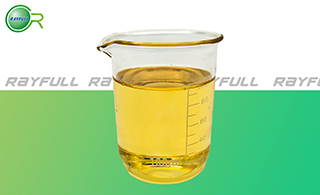CYHALOFOP BUTYL
    氰氟草酯 氰氟草酯
Introduction: A selective herbicide used for post-emergence control of grass weeds usually in rice crops.
Common name: Cyhalofop Butyl
Another name: Clincher, Cyhalofop Butyl, Cyhalofop-butyl [ISO], UNII-18HGV9OC6G, Cyhalofop butyl ester, etc.
Chemical name: butyl (R)-2-[4-(4-cyano-2-fluorophenoxy)phenoxy]propionate
Empirical formula: C16H12FNO4
Structural formula:

Mol. Weight: 357.38 g/mol
CAS No.: 122008-85-9
Specifications
Leading Cyhalofop Butyl supplier
Cyhalofop Butyl 100 g/L EC
Cyhalofop Butyl 100 g/L EW
Cyhalofop Butyl 200 g/L EC
Cyhalofop Butyl 95% TC
Cyhalofop Butyl 97% TC
Packing:
BULK PACKING
Solid: 25kg/Bag, 25kg/Drum, 50kg/Drum etc.
Liquid: 200L/Drum, 20L/Drum, 10L/Drum ect.
SMALL PACKING
Solid: 1kg/Alu bag, 500g/Alu bag, 200g/Alu bag, 100g/Alu bag, 50g/Alu bag, 15g/Alu bag etc.
Liquid: 5L/Drum, 1L/Bottle, 500ml/Bottle, 250ml/Bottle, 100ml/Bottle, 50ml/Bottle etc.
Customerized packing label
Professional registration
HAZARDS IDENTIFICATION
Hazard statement(s)
H373: Causes damage to organs through prolonged or repeated exposure.
H400: Very toxic to aquatic life.
H410: Very toxic to aquatic life with long lasting effects.
Precautionary statement(s)
P260: Do not breathe dust/fume/gas/mist/vapors/spray.
P273: Avoid release to the environment.
P314: Get medical advice/attention if you feel unwell.
P391: Collect spillage.
P501: Dispose of contents/container to ...
Supplemental Hazard Statements: none
MAMMALIAN TOXICOLOGY
Acute toxicity: 1) Acute oral LD50 for rat: >5000 a.i.mg/kg. 2) Acute dermal LD50 for rat: >2000 a.i.mg/kg. 3) Inhalation LC50 (4 h) for rat: >5.63 a.i.mg/L. 4) Not irritant to skin (rabbits). 5) Slightly irritating to eyes (rabbits). 6) Not sensitising (guinea pig).
NOEL: For male rats is 0.8 mg/kg b.w. daily, female rats is 2.5 mg/kg b.w. daily. Non-mutagenic in Ames, DNA repair and micronucleus tests. Not teratogenic. In in vivo cytogenetic studies, no induction of structural chromosomal aberration observed. Rat and rabbit studies indicate cyhalofop-butyl is not teratogenic.
ADI: 0.003 mg/kg b.w./day
Classification:
Toxicity class WHO (a.i.): U (Unlikely to present an acute hazard)
US EPA Classification (formulation): II (Warning - Moderately toxic)
ECOTOXICOLOGY
Effect on birds: low toxicity to birds, acute oral LD50 for Bobwhite quail is >2250 a.i.mg/kg. Effect on fish: moderate toxicity to fish, acute 96 hour LC50 for Bluegill sunfish is 0.79 a.i.mg/L. Effect on aquatic invertebrates: moderate toxicity to aquatic invertebrates, acute 48 hour EC50 for Daphnia magna is >2.7 a.i.mg/L. Effect on algae: moderate toxicity to algae, acute 72 hour EC50 for Scenedemus subspicatus is >0.96 a.img/L. Effect on honeybees: low toxicity to honeybees, contact acute 48 hour LD50 is >100 a.i.μg/bee, oral acute 48 hour LD50 is >100 a.i.μg/bee. Effect on earthworms: low toxicity to earthworms, acute 14 day LC50 is >1000 a.i.mg/kg.
ENVIRONMENTAL FATE
Cyhalofop-butyl's production may result in its release to the environment through various waste streams; its use as an herbicide will result in its direct release to the environment. If released to air, a vapor pressure of 4.0×10-7 mm Hg at 25 deg C indicates cyhalofop-butyl will exist in both the vapor and particulate phases in the ambient atmosphere. Vapor-phase cyhalofop-butyl will be degraded in the atmosphere by reaction with photochemically-produced hydroxyl radicals; the half-life for this reaction in air is estimated to be 17 hours. Particulate-phase cyhalofop-butyl will be removed from the atmosphere by wet and dry deposition. If released to soil, cyhalofop-butyl is expected to have low mobility based upon an estimated Koc of 1,500. Volatilization from moist soil surfaces is not expected to be an important fate process based upon a Henry's Law constant of 9.4×10-9 atm-cu m/mole. Volatilization from dry soil surfaces is not expected based upon cyhalofop-butyl's vapor pressure. Half-lives of 3-11 hours in soil indicate microbial metabolism is rapid. A half-life of 0.5 days has been reported for the photolysis of cyhalofop-butyl on soil. If released into water, cyhalofop-butyl is not expected to adsorb to suspended solids and sediment based upon the estimated Koc. Half-lives of 2.4-4.4 hours and 0.2 days have been reported for the aerobic and anaerobic aquatic metabolism of cyhalofop-butyl respectively. Volatilization from water surfaces is not expected to be an important fate process based upon this compound's Henry's Law constant. Half-lives for the photolysis in water are reported to be 27.9-159.3 days. An estimated BCF of 71 suggests the potential for bioconcentration in aquatic organisms is moderate. Chemical hydrolysis half-lives of 88 and 2.1 days at pH 7 and 9, respectively, have been reported for cyhalofop-butyl. Occupational exposure to cyhalofop-butyl may occur through inhalation and dermal contact with this compound at workplaces where cyhalofop-butyl is produced or used. (SRC)
Usage: Discovered in the mid-1980s by The Dow Chemical Company (now Dow AgroSciences) and reported by P. G. Ray et al. (Proc. 10th Australian & 14th Asian-Pacific Weed Conference, Brisbane, Australia, September 1993, p. 41). Introduced in Asia in 1995; now marketed in rice-growing territories worldwide. Patents: US 4894085 (1990); US 4897481 (1990); EP 302203 (1989). Manufacturers: Dow AgroSciences. Biochemistry: Fatty acid synthesis inhibitor, by inhibition of acetyl CoA carboxylase (ACCase). Selectivity between susceptible grasses and dicotyledonous plants is attributed to the forms of ACCase present and their compartmentalisation within plant cells. Susceptible grasses contain the susceptible eukaryotic form of ACCase; dicotyledonous plants contain both susceptible eukaryotic and herbicide-resistant prokaryotic forms of ACCase, rendering them resistant to cyhalofop-butyl. Rice tolerance to cyhalofop-butyl is due to rapid metabolism to the herbicidally inactive diacid (t1/2 <10 hr), whereas susceptible grasses metabolise cyhalofop-butyl to the herbicidally active monoacid.
Application: Post-emergence herbicide with foliar uptake only and no soil activity. A systemic herbicide that is readily absorbed by plant tissue, is moderately phloem-mobile and accumulates in meristematic regions. Grass weeds cease growth immediately after treatment, with yellow patches appearing within 2-3 days to one week, leading to necrosis and death of the whole plant within 2 to 3 weeks. For post-emergence control of grass weeds in rice. Applied at 75-100 g/ha in tropical rice and 180-310 g/ha in temperate rice. Rice is completely tolerant to due to rapid metabolism to the inactive diacid.
| 






